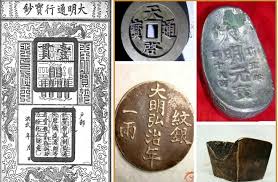By the late 1500s, the Ming Dynasty transformed global trade by adopting silver as its primary currency. This monumental shift, spurred by tax reforms that required payments in silver, created an insatiable demand for the precious metal. Silver became the lifeblood of China’s economy, connecting it to trade networks spanning the Americas, Europe, and Asia. This era, often referred to as China’s Silver Century, established the country as a global catalyst for silver trade, influencing the flow of wealth and goods across the world.

The Tax Reforms That Changed Everything
- The Single Whip Reform (1581):
- The Ming government consolidated its complex tax system into a single payment, requiring taxes to be paid in silver instead of goods or labor.
- This reform simplified governance and improved revenue collection but created a massive demand for silver across all levels of Chinese society.
- Economic Integration:
- Farmers, merchants, and landowners now needed silver to meet their tax obligations, driving an increase in silver’s importance as a medium of exchange.
- Silver became the de facto currency for trade, replacing other forms of payment like grain or paper money, which had suffered from rampant inflation.
The Global Hunt for Silver to Satisfy China’s Demand
- The Americas as the Primary Source:
- Spanish mines in Potosí (Bolivia) and Zacatecas (Mexico) supplied vast amounts of silver that ultimately flowed into China.
- Spain’s Manila galleons transported silver from the Americas to the Philippines, where it was traded for Chinese silk, porcelain, and other luxury goods.
- The “Silver Drain” Phenomenon:
- An estimated two-thirds of all American silver mined during this period ended up in China.
- The continuous flow of silver to China highlighted its central role in global trade, as European and Asian merchants alike sought to exchange goods for Chinese wares.
- European and Asian Intermediaries:
- European traders, such as the Portuguese and Dutch, played a key role in transporting silver to China, often through the Indian Ocean trade routes.
- Japan, which also had significant silver mines, became another key supplier, further strengthening China’s integration into the global economy.
Silver’s Role in Strengthening China’s Economy
- Market Expansion:
- The widespread use of silver facilitated the growth of regional and international markets in China, fostering economic dynamism.
- Chinese merchants became key players in the global economy, exchanging goods like silk, tea, and porcelain for silver.
- Stabilization and Wealth Accumulation:
- Silver helped stabilize the Ming economy, as its intrinsic value provided a reliable medium of exchange compared to the devalued paper currency of earlier dynasties.
- Landowners and wealthy merchants accumulated vast stores of silver, reinforcing its status as a symbol of wealth and power.
Challenges and Consequences of the Silver Economy
- Dependence on Foreign Silver:
- While the influx of silver fueled economic growth, it also made China heavily dependent on foreign sources of the metal. This reliance left the economy vulnerable to disruptions in global silver supplies.
- Socioeconomic Inequality:
- The need to pay taxes in silver placed a significant burden on peasants, who had to sell their goods at low prices or borrow silver at high interest rates.
- Wealth inequality grew as landowners and merchants benefited disproportionately from the silver-based economy.
- Economic Strains in the Late Ming Dynasty:
- By the early 1600s, disruptions in silver supply—caused by political turmoil in Europe, piracy, and Japan’s decision to reduce silver exports—exacerbated economic difficulties in China.
- This contributed to fiscal crises that weakened the Ming Dynasty and paved the way for the rise of the Qing Dynasty.
China’s Role as a Global Catalyst
The Ming Dynasty’s adoption of silver currency reshaped global trade, making China the epicenter of the world’s economy during this era. The insatiable demand for silver not only linked China to distant lands but also drove the extraction of resources in the Americas, the expansion of European empires, and the development of complex trade networks.
Conclusion: A Century of Global Impact
China’s Silver Century highlights how the Ming Dynasty’s economic policies transformed the world. By anchoring its economy to silver, China became a magnet for global wealth and trade, solidifying its position as a dominant force in the early modern world. Yet, this reliance on silver also revealed the vulnerabilities of global interconnectedness, as economic shocks in one region could ripple across continents.
